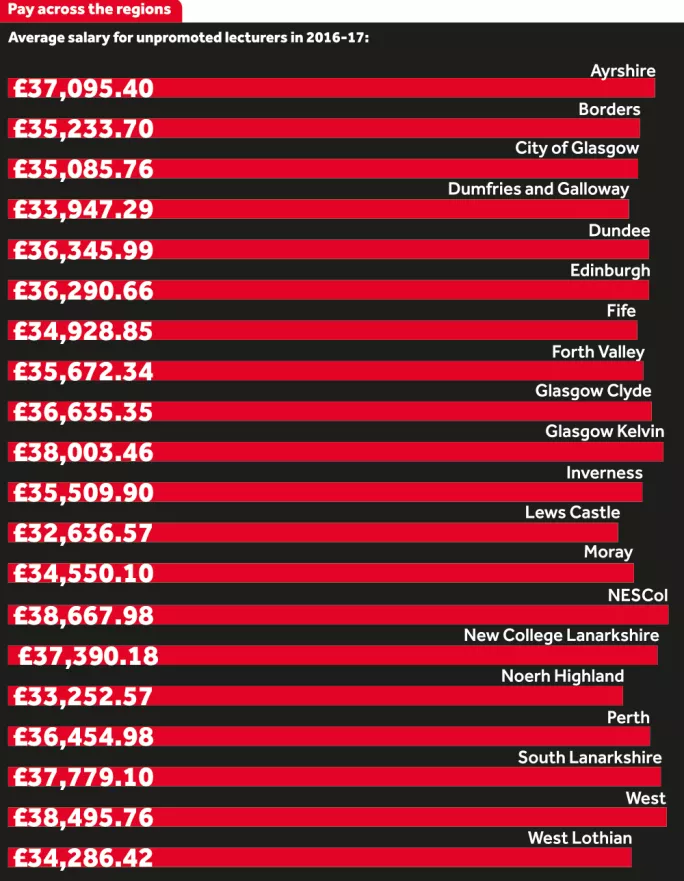Lecturers earn more in Scotland

College lecturers at Scottish colleges have a higher average salary than those in London, according to new figures.
Today’s annual Further Education Workforce Data for England report, published by the Education and Training Foundation (ETF), highlights that the average pay for college teachers in 2015-16 was £30,288. With a one per cent increase recommended in England last year, that would take that average up to £30,590.88 for 2016-17 - although many colleges did not, in fact, increase teacher pay.
Figures for 2016-17 from the Colleges Scotland Employers’ Association, obtained exclusively by Tes Scotland, show that this is significantly lower than the average pay at every Scottish college, and over £6,000 lower than the Scottish average provided by the employers’ association, which is £36,837.
Pay at Scottish colleges varies widely owing to decades of local bargaining arrangements. The figures show that the college with the lowest average pay is Lews Castle College UHI, at £32,636.57, while the highest average salary is paid at North East Scotland College, with £38,667.98.
Recent years saw a return to national bargaining in the Scottish college sector, although progress has been slow. While a deal was agreed last year, this year saw strike action by lecturers, accusing management of reneging on that deal.
The strike was suspended to allow for a deal to be finalised, although earlier this month the EIS teaching union, which represents lecturers, warned that the dispute could reignite if colleges did not make initial payments by the end of July. College management said the deal required ratification by both sides.
If that deal was agreed, it would include a commitment to move all unpromoted lecturers in Scotland onto a pay scale towards a salary of around £40,000 - almost 25 per cent more than the average pay at English colleges.

The ETF figures show regional variations at English colleges. The highest median pay in London is £36,613, followed by the East Midlands at £32,246, the South at £31,673 and the North at £31,218.
This means that seven of the 20 Scottish colleges included in the national bargaining process have an average salary higher than the median pay at colleges in London.
The EIS teaching union, which represents Scottish college lecturers, said that it was widely accepted that Scottish colleges undertake more higher education teaching than English colleges - with UHI FE colleges, for example, delivering all levels of higher education, including degrees and postgraduate qualifications.
A spokesman explained that unlike national bargaining in Scotland, negotiations in England generated only a recommendation.
“Scotland has one recognised trade union (EIS) with a high membership density, allowing a single union to plan and conduct negotiations and then move to a co-ordinated industrial action strategy at every college.”
He added the £40,026 was “an agreed top-of-the-scale salary agreed by the employers and EIS in March 2016”.
A spokeswoman for the Colleges Scotland Employers’ Association said Scottish lecturers had higher earnings compared to their counterparts in England, partly as a consequence of the mergers of colleges and the resulting harmonisation at a regional level, as well as the instigation of national bargaining, she said.
“It is important to recognise that the post-16 education landscape is different in England,” she said. “The process of national bargaining is to create a standardised salary and terms and conditions for lecturers, and this is resulting in increased wages across the sector. But it is important to recognise that, alongside this, there need to be professional standards and registration.”
A spokesman for the Scottish government stressed that the sector south of the border was not directly comparable with Scotland’s colleges, as it also included autonomous further education colleges, specialist colleges and sixth-form colleges.
“Our focus is on delivering a modern and flexible college workforce, which rewards staff appropriately, meets the needs of students, and supports economic growth,” he said.
You need a Tes subscription to read this article
Subscribe now to read this article and get other subscriber-only content:
- Unlimited access to all Tes magazine content
- Exclusive subscriber-only stories
- Award-winning email newsletters
Already a subscriber? Log in
You need a subscription to read this article
Subscribe now to read this article and get other subscriber-only content, including:
- Unlimited access to all Tes magazine content
- Exclusive subscriber-only stories
- Award-winning email newsletters